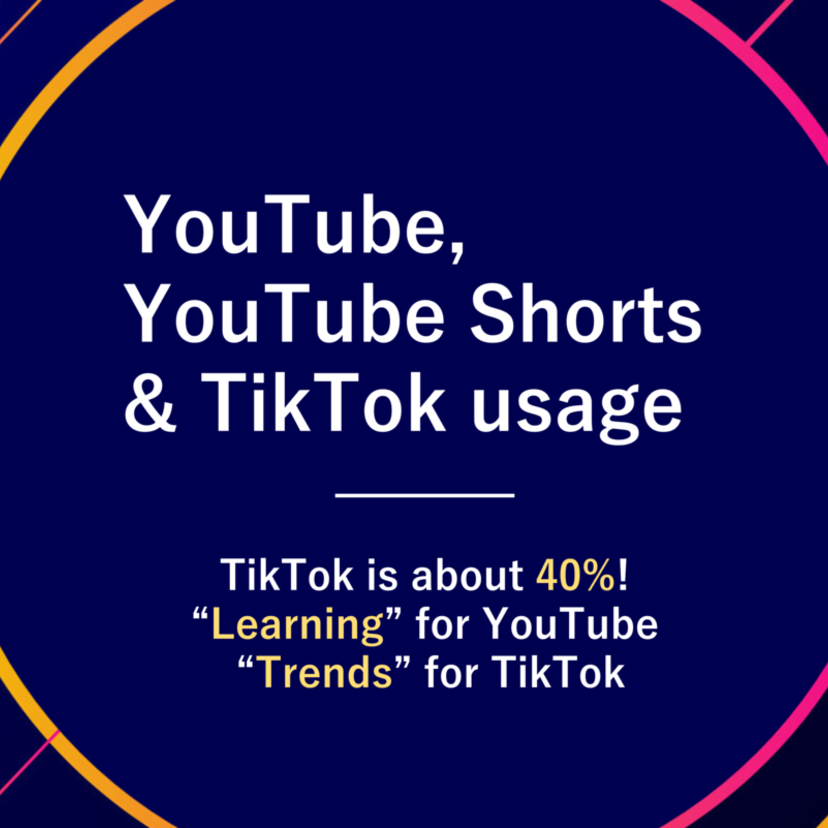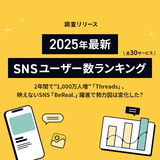40% use YouTube every day. TikTok usage rate is about 40%, polarized into heavy users and non-users
First, when we asked all respondents about how often they use each medium, we found that approximately 40% of respondents use YouTube “Almost every day,” while people who watched both YouTube Shorts and TikTok “Almost every day” is limited to about 1/4 of the total respondents. On the other hand, the percentage of people who “Don’t use it at all” increases in the order of YouTube, YouTube Shorts, and TikTok, with approximately 60% of respondents not using TikTok.
Compared to other media, TikTok is becoming increasingly polarized between those who use it every day and those who don't use it at all.
When calculating the usage rate among respondents by adding up the percentages of people, excluding those who answered “Don’t use it at all,” for each medium, it was approximately 81% for YouTube, approximately 63% for YouTube Shorts, and approximately 41% for TikTok.
*In the main text, regular YouTube videos that do not include short-form videos are referred to as “YouTube.”

Next, we asked about average usage time per day.
Overall, for all media, as the length of time increases, the percentage of respondents tends to decrease, but YouTube Shorts is unique in that it alone, it exceeds 50% of respondents for “1 minute or more & less than 30 minutes.” In addition to the fact that each YouTube Shorts is short many people tend to watch it like a “snack,” or a quick watch, between regular YouTube videos, and there may be fewer people who only watch Shorts for hours on end.
On the other hand, the percentage of people who said they use TikTok for "3 hours or more & less than 4 hours" was about 10%, about twice as much as YouTube and four times as much as YouTube Shorts. In addition, when we defined “heavy users” as those who use TikTok for more than 3 hours, we found that TikTok had the highest rate, with just under 20% of respondents, which is the highest among the three media, making heavy usage among TikTok significant.

"Gaming commentary" is concentrated on YouTube, "Pet/Animal " and "Cooking" are popular regardless of medium
So, what kind of videos do users actually often watch for each medium? We have ranked the results in descending order of response rate and have listed the top 15.

*There are a total of 33 options below.
Beauty/Makeup/Fashion, Dance covers, Lifestyle (Vlog/Morning routine, etc.), Variety Show (I tried…, quiz, relatable, etc.) Explanation/Analysis, Psychic, Music video / Music, Gaming commentary, Mukbang, Self-Development (Business/Mindset, etc.), ASMR, Comedy/Impersonations, News programs, Clips, Pets/Animal, Cooking, Specialized knowledge/Experiences, Outdoor (camping, fishing, hiking, etc.), Couples, Anime/Drama, Educational (English, mathematics, cram school instructor commentary, etc.), Lifehack, VTuber, Product introduction, Gluttony, Restaurant introduction, Sports, Family/Childcare, Travel & introduction to regions/countries, TV personality (entertainer, voice actors, idols, etc.), Fitness/Training, Other, I don't know / I don't remember.
On YouTube, “Music video / Music” and “Gaming commentary” are at the top with over 20%, probably due to the demand for listening to background music. It is also characteristic that “Specialized knowledge / Experiences,” which tends to demand careful viewing, has a higher ratio of users than YouTube Shorts (16th place) and TikTok (19th place).
What all three media have in common is that "Pet/Animal" and "Cooking" are ranked high. Especially on TikTok, both of them occupy the 1st and 2nd place respectively. These seem to be popular content, regardless of video length.
On the other hand, there was a big difference between the three media in "Gaming commentary." “Gaming commentary” accounts for about 20% (2nd place) on YouTube, while it accounts for about 10% (7th place) on YouTube Shorts and about 8% (15th place) on TikTok. On YouTube, in addition to wanting to keep the full video running as background music while working, there is also a strong need to watch the full video in order to enjoy the gaming video or live commentary itself.
When it comes to gaming commentary, I get the impression that there are a lot of short video clips. "Clips" is ranked third in YouTube Shorts, but how often are people “watching the full video after becoming interested after watching the clip.”

Regarding “watch[ing] the full version of the video after watching a clip in YouTube Shorts” and “watch[ing] a content creator’s normal YouTube video (not Shorts) after recognizing them in a YouTube Shorts,” the changes from YouTube to YouTube Shorts, approximately half of all these transitions were “often” or “occasionally,” indicating that the split was almost evenly split between those who transition to other mediums and those who don’t.
On the other hand, the total percentage of respondents that “watch the TikTok after recognizing a video from a content creator on YouTube” was about 40%. This is slightly lower than the those who transition within YouTube (transition between full YouTube videos and YouTube Shorts). However, if you consider the hassle of jumping between apps and moving between platforms, the number may be higher than you imagine.
Is “watch[ing] the video while reading comments” or “skip[ing] through the video” due to “Taipa”?
Next, we asked about their usage styles for each medium.
On YouTube, “Find videos with search,” “Watch videos of content creators I always watch or know,” and “Subscribe to (follow) channels” were each ranked in the top 3 with the around the same percentage of over 25%.
On the other hand, with YouTube Shorts, just under 10% of people said they “Subscribe to (follow) channels,” giving the impression that it is difficult to get people to subscribe. As you watch the Shorts from various content creators, you may enjoy the videos themselves, but it may be difficult to find the motivation to subscribe to the channel.

Regarding viewing comments on YouTube, YouTube Shorts, and TikTok, “Watch the video while reading comments” is higher than “Read the comments after watching the video.” In particular, on YouTube, about 17% of respondents said they “Watch the video while reading comments,” and there are very “Taipa” (abbreviation for “time performance” and often used to describe behaviors consider the effective use of time) opinions, such as “just watching videos feels like a waste of time” and those who “just turn on the sound and want to know listen to others’ opinions,” with many people enjoying the video and comment section at the same time. In this way, it seems that a certain number of people not only enjoy the video itself, but also enjoy seeing how other users who are watching the same video empathize with each other and share their opinions.
Speaking of “Taipa,” on YouTube, “Skip[ping] through the video” ranked 7th with 17%, and “Playing back in 2x speed” ranked 9th with 10%. Furthermore, “Skip[ping] through the video” ranked 6th at 10% for YouTube Shorts, and 6th on TikTok at 14%, indicating that a high rate of people skip through short-form videos as well.
How are they used differently? Keywords are “Learning” on YouTube & “Trends” on TikTok
In order to explore the different uses of YouTube, YouTube Shorts, and TikTok, we asked respondents who answered that they "use" all of the media to choose the media that most closely resembled an impression (e.g., Person A feels that YouTube is the medium that they feel has “High quality of content”).
“Can watch during free time” was ranked first on both YouTube Shorts and TikTok. On TikTok, over 50% of respondents answered “Can watch during free time,” indicating that TikTok is recognized as entertainment that can be easily enjoyed during a short amount of spare time. “First open when I am bored or on my smartphone” also ranks high for both YouTube Shorts and TikTok, ranking third.
On the other hand, on YouTube, “Can watch during free time” ranked 13th, while “Watch when I have emotional leeway” ranked first with half of the respondents having this impression. Since long-form videos require a lot of time and concentration to enjoy, it seems that they are used differently from short-form videos depending on the situation and mode.

Surprisingly, the percentage of people who said "Can multitasking while watching" was around 35% on TikTok, which is about the same as on YouTube. The impression that the content that can be enjoyed while multitasking is difficult to replace with short-form videos may be overturned as demand for watching multitasking while watching on TikTok continues to grow.
Other notable features were that on YouTube, there are “Plenty of learning-related content,” and TikTok is “Strong in trend-related information,” each being selected by half of the respondents. YouTube and TikTok may be used differently depending on the purpose, such as YouTube being used for learning something new and TikTok for watching trends. On the other hand, the percentage of people who selected "Can use for ‘Oshikatsu’" (“Oshikatsu” are activities that fans do to support their favorite idols, anime characters, etc.) was around 30% for both YouTube and TikTok, indicating that both media are used equally for “Oshikatsu.”
Less than 10% of all media said “I purchased a product after seeing an ad”
Next, in order to measure the effectiveness of promotions on each media, we asked participants about their media-based behavior.

Looking at how much “ads,” “videos with promotions,” and “videos without promotions” each led to purchases, the percentage of people who said they made purchases on each medium was less than 10%.
There is no big difference in the percentage of respondents between YouTube, YouTube Shorts, and TikTok, but you can see that YouTube Shorts is slightly lower than other media. After all, the mode may be slightly different from when watching regular videos on YouTube.
For those who answered that they have "used” all three media, we asked them to select the media that led to the purchase of the product the most times. The results showed that YouTube, TikTok, and YouTube Shorts had the highest percentages in that order, at approximately 30%, more than 20%, about 10%, respectively. We would like to keep an eye on whether the number of purchasing experiences on TikTok will increase in the future.

In this research, we asked heavy users who use each medium almost every day about their purchasing behavior, and there were no major differences between the mediums. The user groups seem to be similar in terms of purchasing awareness.

[Overview of the research/analysis]
The research was conducted between December 20, 2023 and December 27, 2023 (27,519 respondents) targeting VALUES’ consumer panel (males & females 15 years old & above) across Japan regarding the use of YouTube, YouTube Shorts, and TikTok.
*The questionnaire is weighted according to population by gender and age and internet usage rate.
※日本語での記事はこちらをご確認ください

【調査リリース】YouTube・YouTubeショート・TikTok利用実態 TikTokの利用率は約4割 YouTubeは学び、TikTokはトレンドがキーワード
https://manamina.valuesccg.com/articles/3195高い利用率を誇るYouTubeに対し、YouTubeショートやTikTokといった短尺動画の利用率はどれだけの追い上げを見せているのでしょうか。それぞれでよく見られている動画や、生活の中での媒体の位置づけ、使い方や使い分けとは?商品の購買に一番繋がりやすいのはどの媒体?アンケートデータから、各媒体の利用実態を調査しました。






















Born and raised in the Bay Area, U.S.A, I was fascinated by the different social and purchasing behaviors between Japanese and American consumers. I studied communication for undergrad and international marketing for my graduate studies. My professional background is in bilingual recruitment and Japanese-English translation.